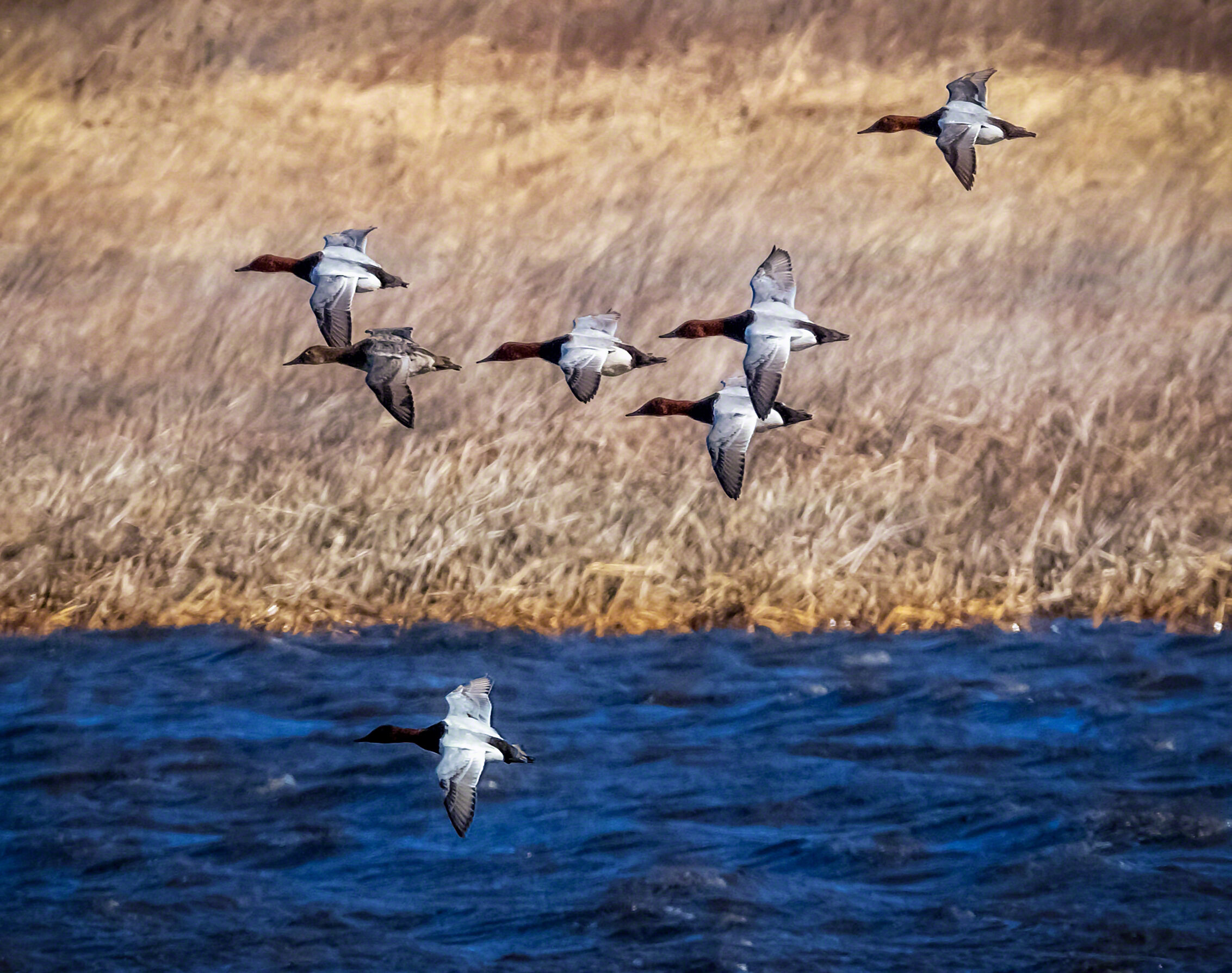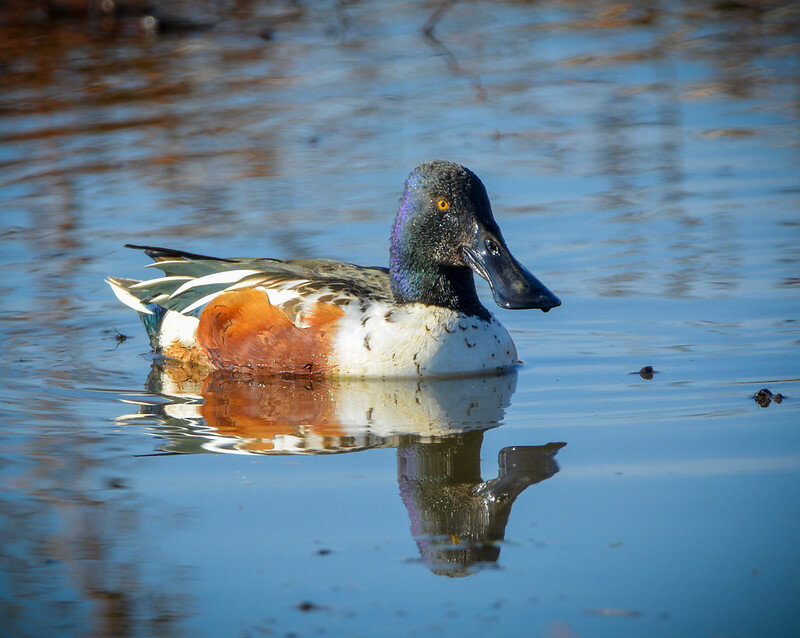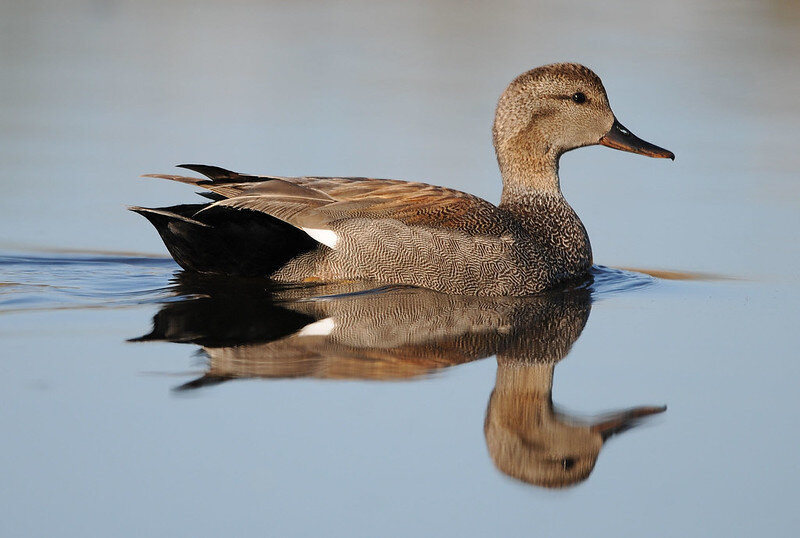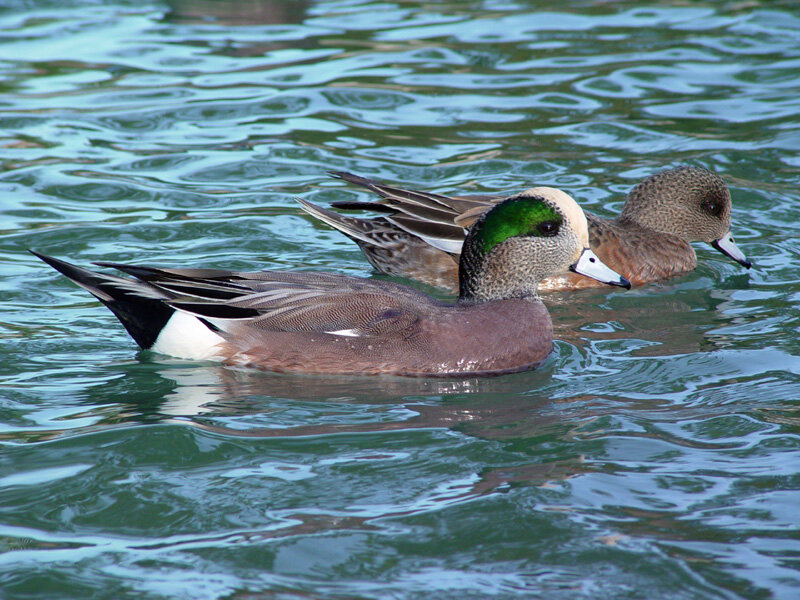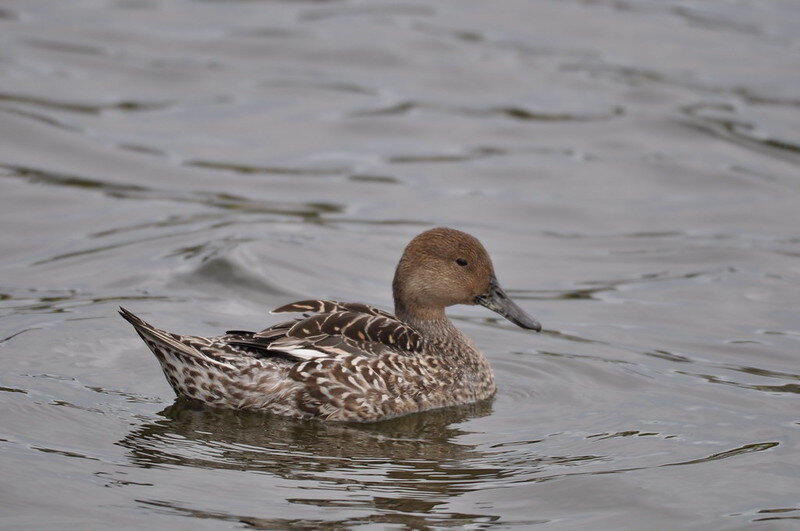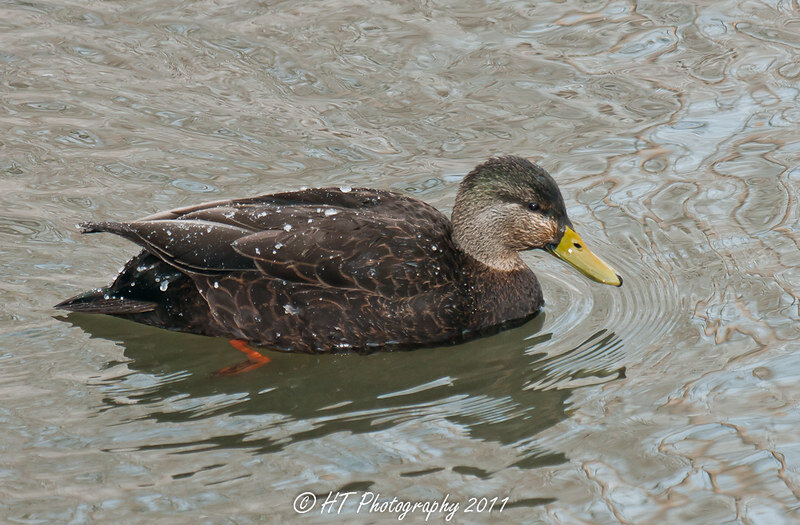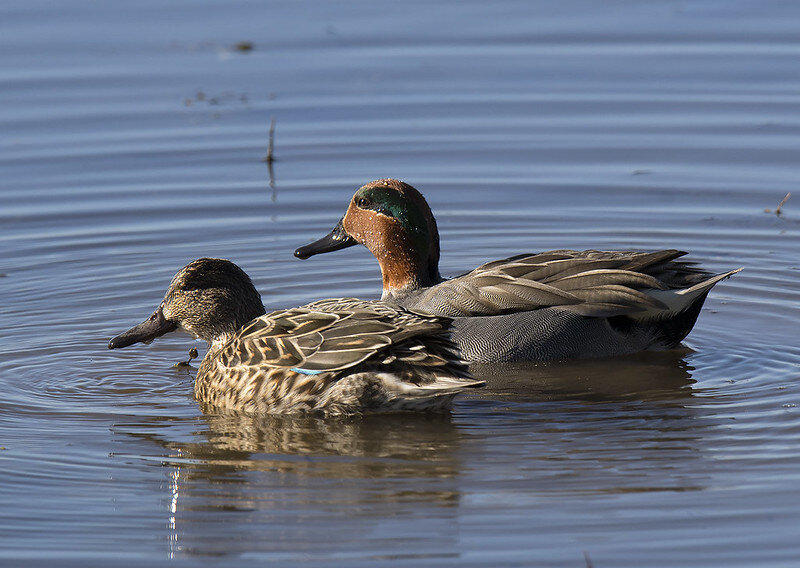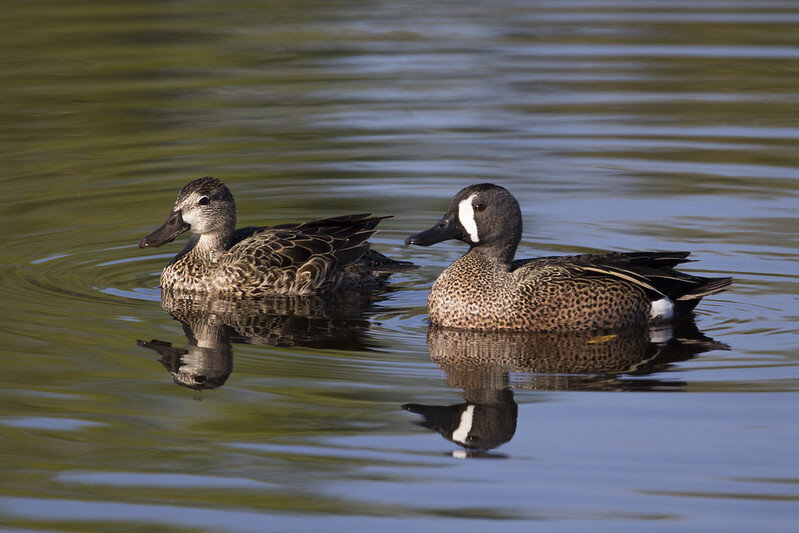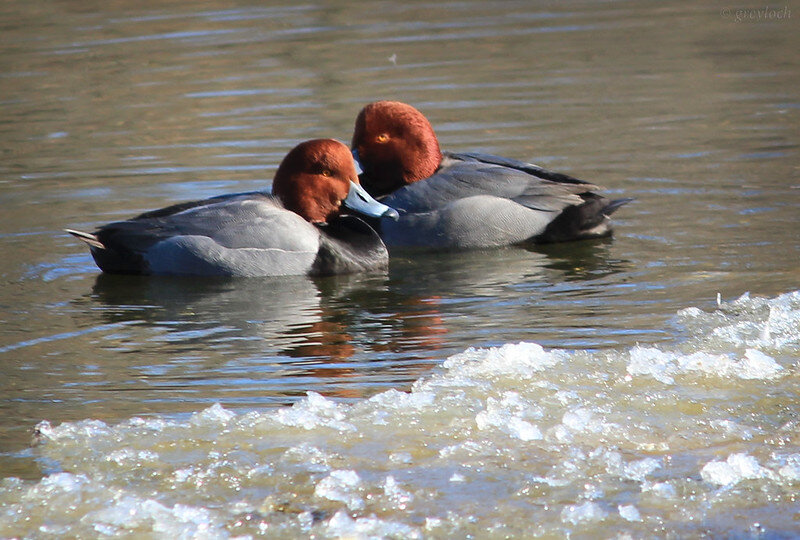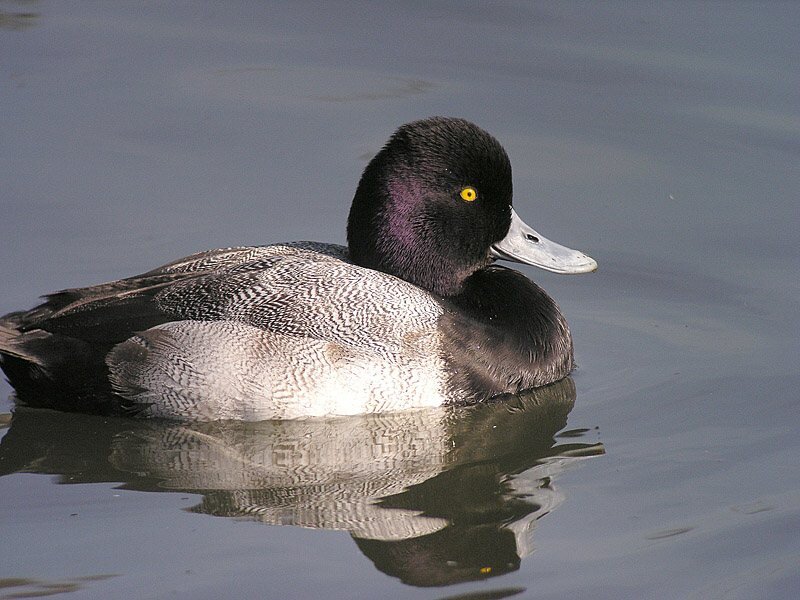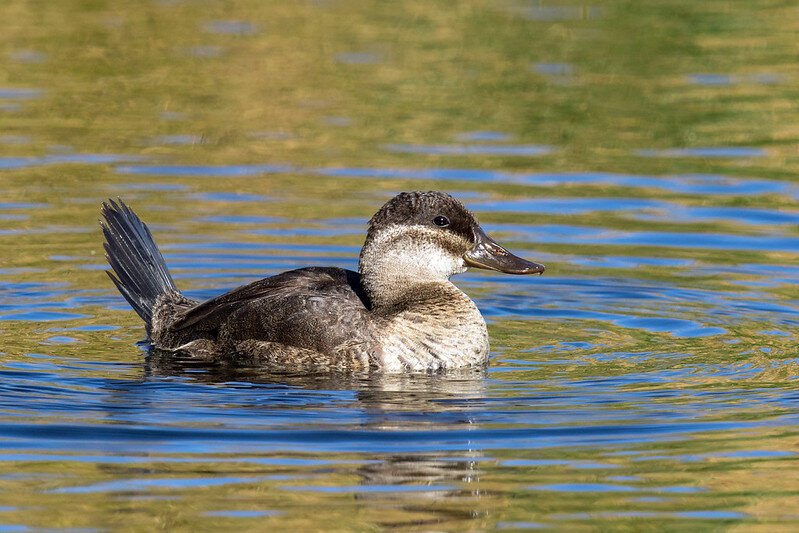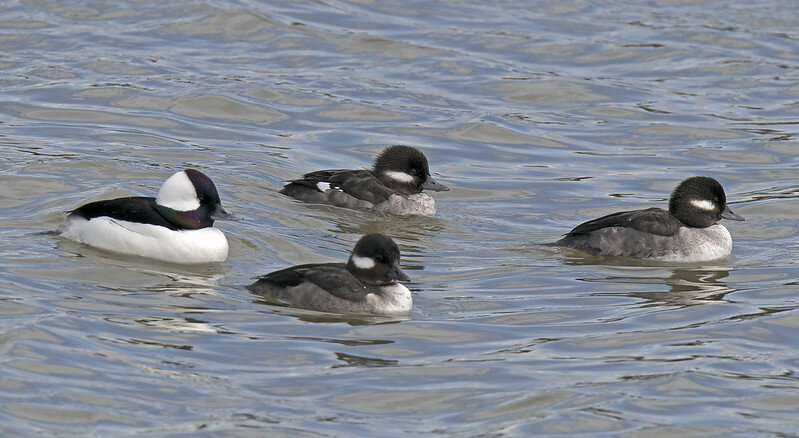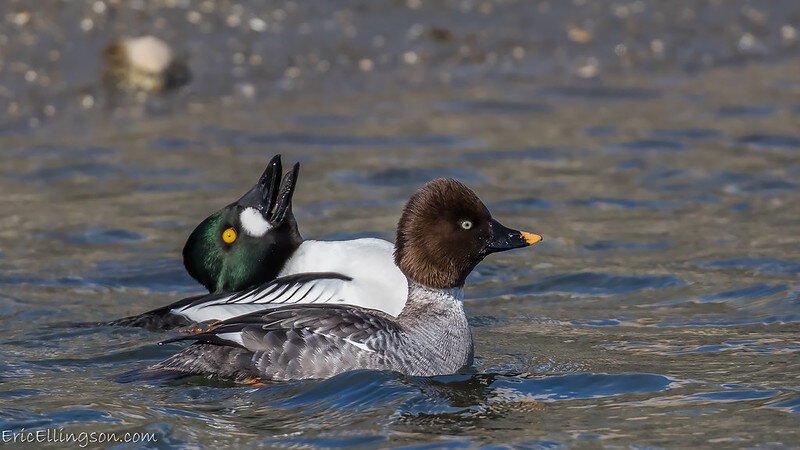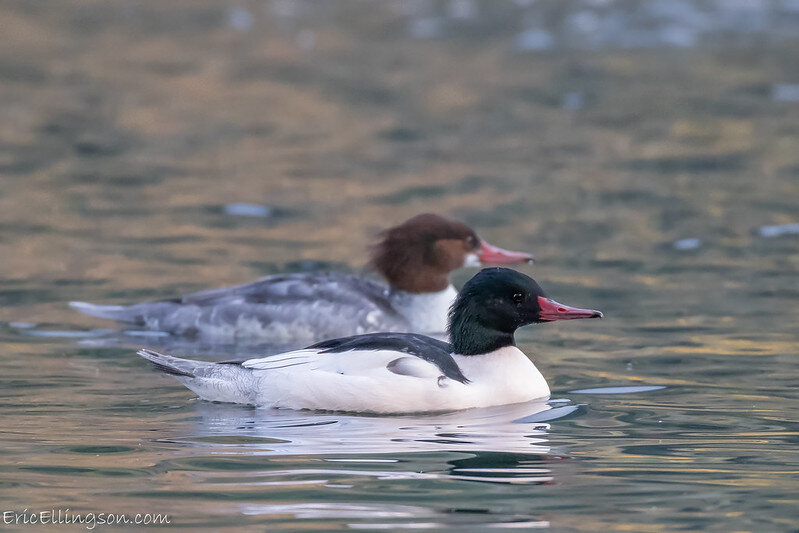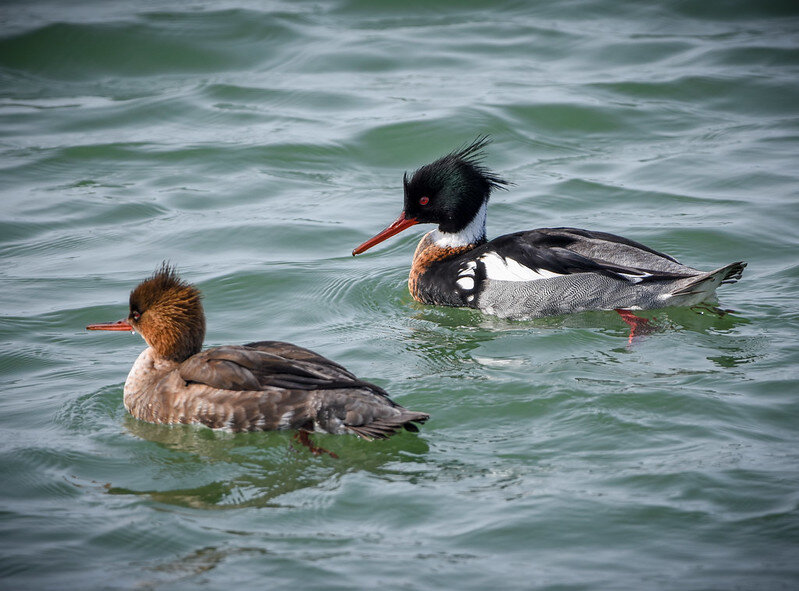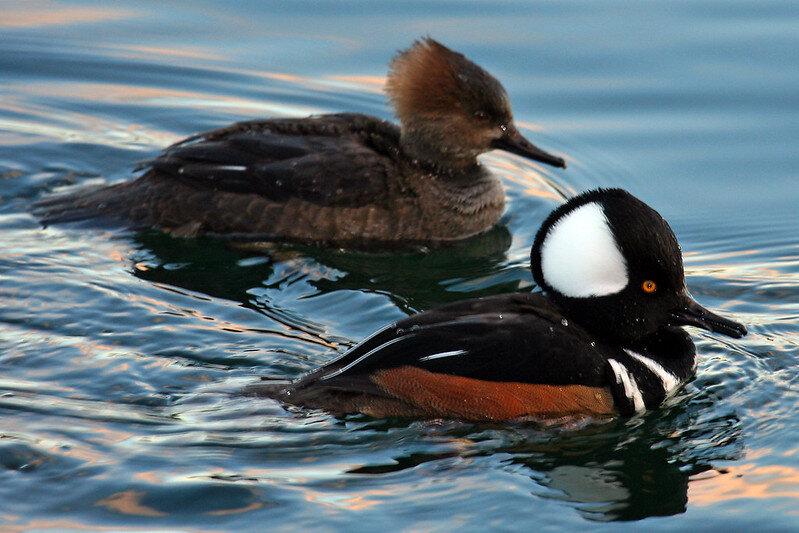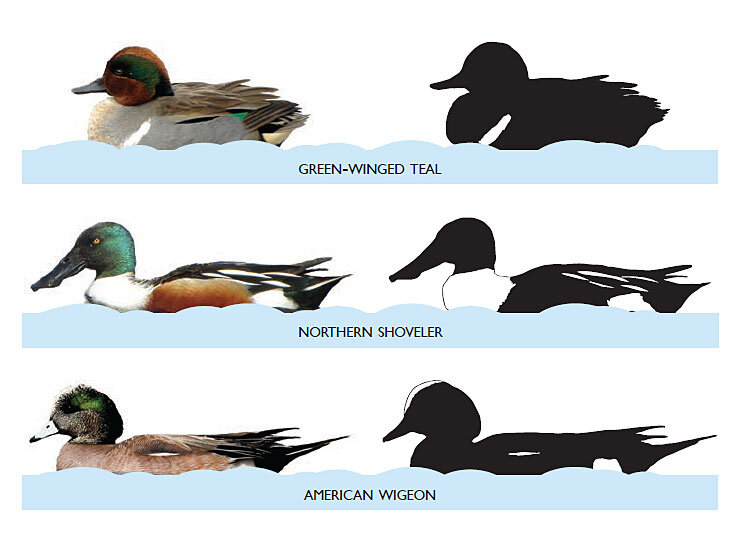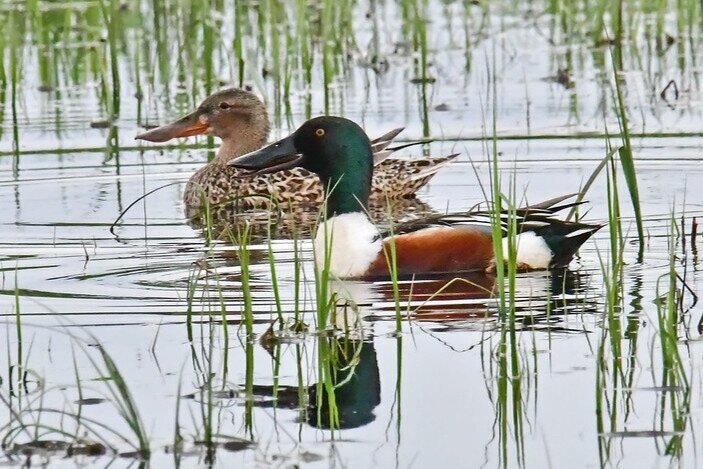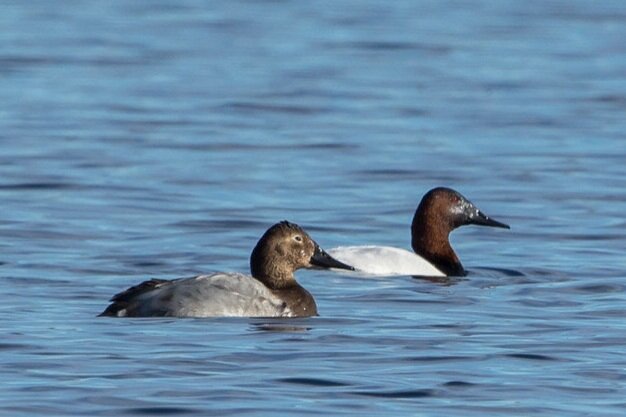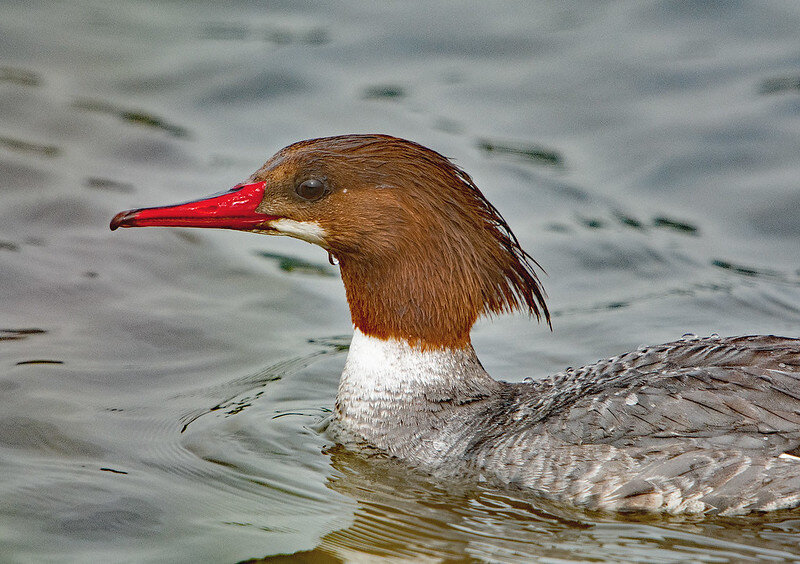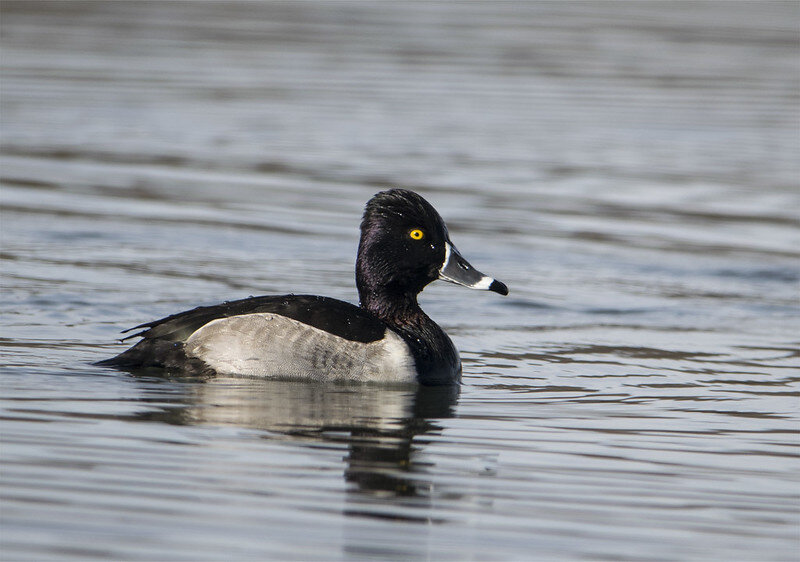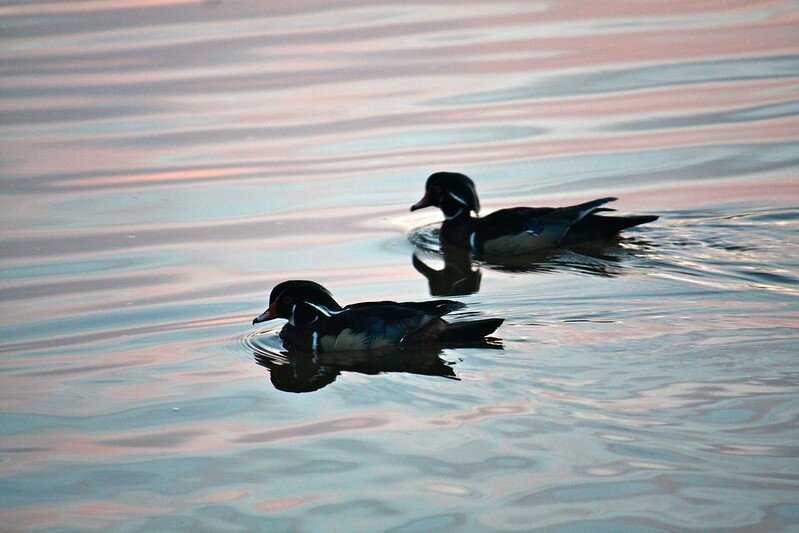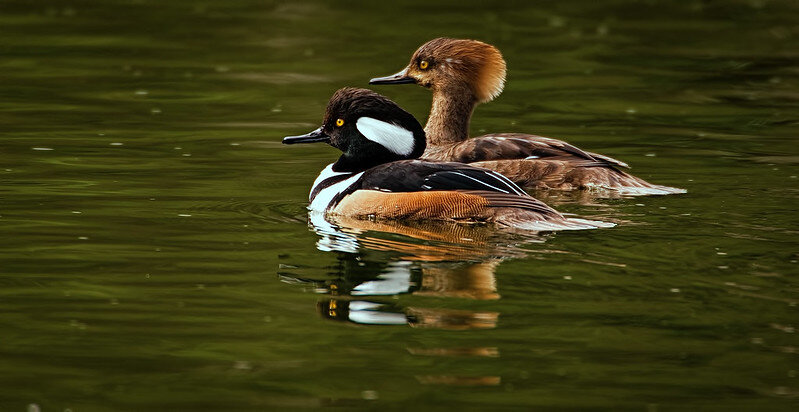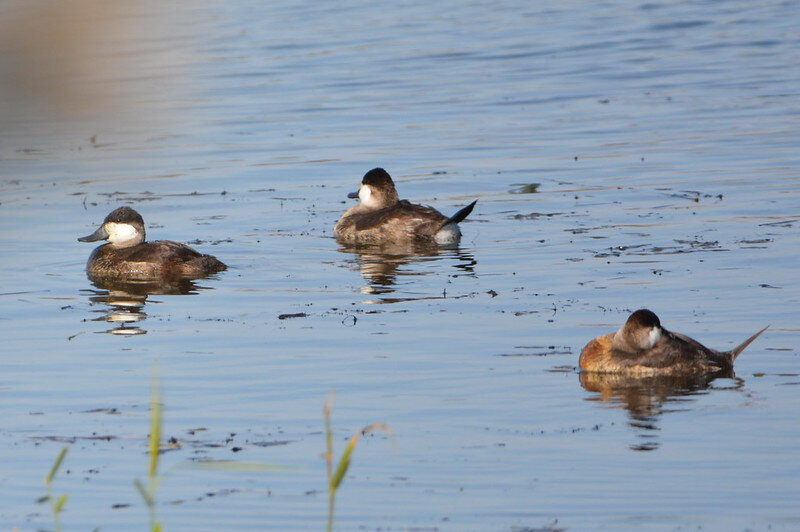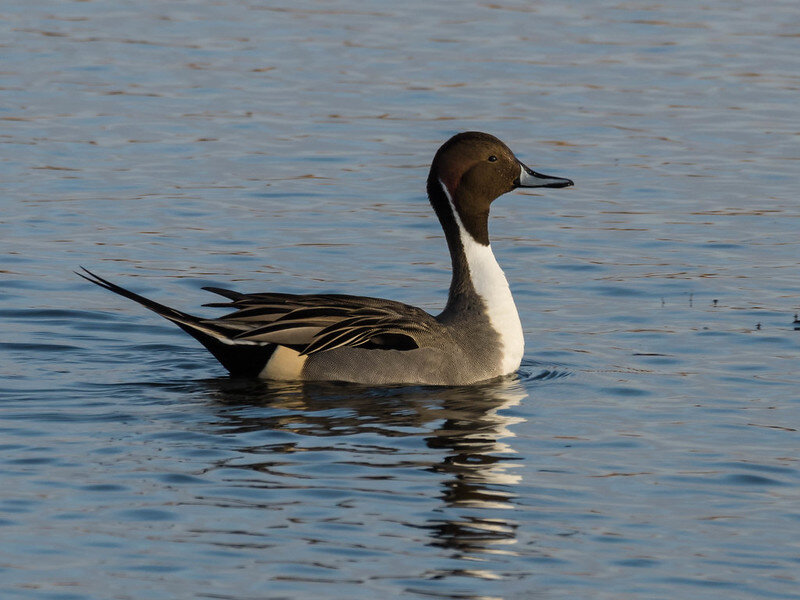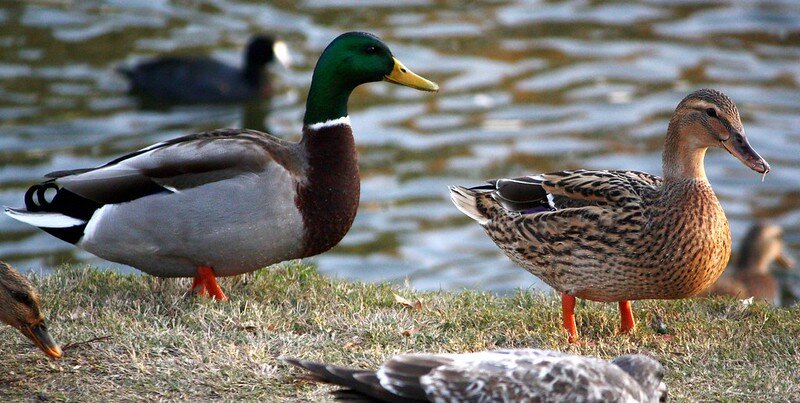Welcome back to the Entryway to Birding blog! Last week, I shared an overview of the incredibly diverse selection of waterfowl that will be visiting us over the next few months. And in the span of a week, things are already ramping up! Out at Goose Pond Sanctuary, tundra swans have arrived, greater white-fronted geese have joined the Canada geese, and a dozen species of ducks are mixed in among them all. Waterfowl migration season is truly here.
Having a general idea of what to expect on the water is one thing, but knowing how to pick out and identify individual species is another. For us newer birders (heck, probably for some experienced folks too!), IDing waterfowl can feel overwhelming. There’s so much variety, not only in species but in the types of viewing conditions you’ll face.
This week’s Entryway to Birding blog has your back. Don’t let those ducks intimidate you! We’ve got all advice you’ll need to sort through a raft of mixed ducks with ease—with or without a scope!
A group of male and female canvasbacks in flight at Goose Pond Sanctuary. Have you visited lately? Now’s the time to make your trip—there’s a lot to see! Photo by Monica Hall
What To Look For — and How To Look
Working towards a bird identification of a species you aren’t familiar with requires piecing together several clues. With any bird—not just waterfowl—there are often several field marks that you need to consider as you make your identification. Seeing a shiny, iridescent green head on a duck doesn’t necessarily mean it’s a mallard. Male northern shovelers sport a very similar green, for instance, but their distinctly-shaped bills will set them apart. In today’s post, we’re going to review five potential types of field marks you could use to cinch your ID of a bird.
If you’re new to waterfowl, I would recommend exploring a few locations where you can get closer looks at birds. Starting your waterfowl identification adventures off with the most distant raft of birds you can find is probably going to be more frustrating than anything. Many of the identification tips we’ll talk about today will “click” for you once you really get a good look at the bird—not just as a distant shape, but a nice close look you can study for awhile.
I had a lot of fun watching this female American wigeon up close at my recent trip to Horicon Marsh. She was constantly budging in front of this American coot, like they had some sort of foraging competition going on. I also enjoyed getting such a good look at her plumage—look at that smoky eye she’s rocking! It’s a great wigeon field mark. Photo by Caitlyn Schuchhardt
Here are some tips to practice as you get acquainted with waterfowl ID:
Explore different habitats. You might immediately think to visit the closest lake near you, but don’t neglect your nearest marsh or tucked away pond! Many of the dabbling ducks can be found in these areas with shallower water.
Be patient, quiet, and still. Some duck species are very flighty and will flush at the slightest noise. They may fly a loop and circle back in to re-land nearby, so don’t panic. Put yourself in “slow birding” mode. Watch and wait. You’ll be surprised what might soon appear from a cluster of reeds or around the corner of a bay.
Choose a duck and follow it. You might find yourself looking at a mixed raft of a bunch of different species. It can be overwhelming to take them all in, so don’t worry about starting with just one. Choose one duck from the group and watch it. You’ll get a lot of insight about its behavior, get to enjoy it from multiple angles as it moves around, and see how it associates with other ducks. Like all birds, ducks have a great amount of personality. The more you watch them, the more you’ll learn what quirky traits they each have.
Now, let’s explore what field marks will help you sort one duck from the next.
DUCK Behavior
Watching how ducks forage for food on the water will help narrow your identification options. Like I mentioned in last week’s post, there are so many species of ducks that they get grouped into categories—the two main categories being “diving ducks” and “dabbling ducks.” Diving ducks will dive below the water as they search for food, while dabbling ducks tend to stay on the surface, tipping their bodies forward and leaving just their rump bobbing above the surface. They might also use their bills to skim food from the water’s surface.
Keep in mind that this isn’t a hard and fast rule—dabbling ducks can and will dive, and diving ducks might sometimes dabble. But you’ll mostly see them doing their characteristic behaviors.
Here’s a quick visual line-up of our region’s dabbling ducks to get you started:
Photos: mallard by Tristan Ferne / northern shoveler by Jen Goellnitz / gadwall by John Church / American wigeon by Henry Cheng / northern pintail by Ethan Gosnell / American black duck by Hal Trachtenberg / green-winged teal by Doug Greenberg / blue-winged teal by Dennis Church
And here is a line-up of our most common diving ducks. They can be tricky in their own right, especially if they are diving frequently. Usually when I want to get a good look, they decide to spend more time underwater than above it, of course …
Photos: canvasback by Dan Streiffert / redheads by Shawn McCready / ring-necked duck by Dave Inman / lesser scaup and greater scaup by x / ruddy duck by Mick Thompson / buffleheads by Doug Greenberg / common goldeneye and common mergansers by Eric Ellingson / red-breasted mergansers by Jen Goellnitz / hooded mergansers by Bill B
This isn’t all the ducks you might possibly see here, but it’s enough to get you a good start. The more you familiarize yourself with the behavior of these different categories of duck, the faster you’ll get at narrowing down an ID. You’ll start to pick up on the little things that also set them apart—like how dabblers can take up straight off the water, while diving ducks need a running start to catch some air.
Plumage — AKA “Where’s the White?”
Ducks can be colorful and varied, but don’t overlook those small patches of white plumage! The location of white on a bird differs for each species, so if you’re remember where the white is, you can easily ID a bird by that alone. Photo from Cornell Lab of Ornithology
You might hear this phrase a lot if you start studying up on waterfowl identification. Kevin McGown, an expert birder and educator who teaches Bird Academy’s Be a Better Birder: Duck and Waterfowl Identification, teaches new birders about how to use the placement of white plumage on a bird to easily identify duck species from afar.
If your viewing conditions aren’t ideal, it can be hard to get an accurate sense of a bird’s plumage. Lighting can play a huge influence on the colors you can (or can’t) see on a bird, and distance can add another challenge. But what usually does stand out, even in bad lighting, is the placement of white feathers.
Learning where those patches of white can be on the body of a particular species can immediately help you make an ID. The Cornell Lab store even sells quick-reference guides that identify these white patches on different species, if that’s something you’re interested in studying up on. You can also look through your field guide and start paying attention to that white placement—if all else fails on a day with poor viewing conditions, it may be the one thing you can see on a bird.
I like to use this “Where’s the white?” tip to confirm my ID on female gadwalls, which to me can look a lot like mallard hens from a distance. I love how easy it can be to pick out the all-black butt of a male gadwall, but a female gadwall doesn’t have that. However, both male and female do have a white patch on their wing that is often (though not always!) visible.
A female (top) and male (bottom) gadwall forage together. The white patch on the female’s secondaries is very visible in this image, but may appear like a small sliver depending on the wing position. Now look at the deep black rear end of that male gadwall. You can just see a hint of the white patch on his wing—a good example of how it can sometimes be hidden. Photo by Ethan Gosnell
Profile and Shape
Getting close or detailed views of waterfowl is sometimes challenging. Maybe they are further away than you’d like and you’re without a scope. Maybe the lighting conditions are poor, resulting in backlit birds or a strong glare that washes out plumage details. Knowing that some birds have unique markers to their profile can help you ID them from a distance. Let’s look at some examples.
Bill shape
Most the ducks you see will have a standard-shaped bill that is reminiscent of a mallard’s, but there are a few ducks with bills that will immediately strike you as unique. This can help you narrow your options down.
Photos: northern shoveler by Thomas Landgren / canvasback by Eric Ellingson / common merganser by Doug Greenberg
You might be looking at a northern shoveler if you see a wide, flat spatula-like bill. From a distance, these bills look thick and heavy. The bill is often recognizable even in flight.
Canvasbacks have a strong, straight slope to their bill as it approaches their head. They lack the concave curvature to their bill like you’d see on a mallard. Their overall plumage pattern can seem similar to a redhead (especially from a distance) because they too have a reddish head and gray back, but a profile view of a canvasback can easily give them away.
Mergansers will have straight, narrow, pointier bills that have a little hook or tip at the end. Their bills are serrated and help them hold onto slippery fish. You might not see those serrations from a distance, but you’ll likely notice the pointy bill shape from afar. Common and red-breasted mergansers will have slightly longer bills than a hooded merganser, but all mergansers will have a “thinner” looking bill.
Head shape
Not all ducks will have the smooth, rounded head of your average mallard. Like other birds, ducks too can have crests and sport some interesting hair-dos. Let’s look at some examples of a few whose head profile might give away their ID.
Photo Credits: ring-necked duck by Chris Bowman / wood ducks by scazon / hooded mergansers by Tim Dickey
Ring-necked ducks have a very tall, peaked head. The slope on their forehead is steep and the feathers on top of their head have this constant “perked up” look to them that makes their heads look a little poofy on top with that added height.
Wood ducks have a unique, rather oblong head-shape that can appear boxy due to the crest on their head. From a distance, and when silhouetted they might be confused for hooded mergansers, which can also have a boxy-headed look but think of that plumage cue from earlier and ask “where’s the white?” on each species—it’s hard to miss that big white patch on a hoodie, which a wood duck will lack.
Male hooded mergansers are able to raise and lower the feathers that form the hooded crest on their heads, so don’t be confused if they aren’t looking quite like you expect. You might see it fully raised into a near-circle, or it may be lowered and more wood-duck-like in its profile.
Tail Shape
When you’re looking from afar without plumage details to aid you, even something like tail shape can help you pick out a few particular birds.
Photos: ruddy ducks by Jen Goellnitz / northern pintal by Amit Patel / mallard by Laura Ferriera
Ruddy ducks have a stiff tail that they tend to keep cocked upright, making it look like they’ve got a popsicle stick attached to their rear. They don’t always hold their tails like this, but will most of the time. If you see a distant flock of birds with their tails pointed up, you can know right away they are ruddy ducks!
Northern pintails have a longer tail than our other common ducks. If you spot a duck whose profile looks surprisingly “elegant” and rather elongated, with a long neck and a long, thin tail, it’s likely a northern pintail.
Have you looked closely at a mallard’s rear? Male mallards have a set of curly tail feathers! While mallards are one of the easier ducks to identify, this little tidbit can help you if you spot those curls on a silhouetted bird or if all you can see is the bird’s rear end as it’s tipped in the water.
Size
Just remember that “teal are tiny!” and you’ll be one step closer to IDing that little duck next to the giant-looking mallard. Photo by Jeff Bryant
I would encourage you to not rely too heavily on size as a field mark, but there are a few birds whose small stature will immediately set them apart in a crowd. Green-winged teal, blue-winged teal, and buffleheads, for instance will be positively dwarfed by a nearby mallard. Ruddy ducks and hooded mergansers are also on the smaller side.
Most ducks will seem of similar size on the water and will likely be far enough away that any small differences will be negligible, so if you do see anything that looks “tiny” in comparison, you can dramatically narrow your search.
Sound
I’m admittedly very poor at identifying waterfowl in flight—IDing them on the water can be hard enough! But one thing that has helped me with a couple of species is sound. I’ve learned to recognize the “oo-eek, oo-eek” call that wood ducks make in flight, so I’ve been able to tell right away the birds that I’ve inadvertently flushed were wood ducks. They kind of sound like a squeaky wheel. Listen here.
Common goldeneye are another bird whose flight sound you can easily pick up. They’ve earned the nickname “whistlers” because their wings will make a distinctive whistling noise in flight. This can help you ID a flock if they fly in or out of a lake. Listen here.
More Resources to Help You Learn
This “Ten Tips for Waterfowl Beginners” article from National Audubon has some excellent advice for newer birders who are turning their eyes to waterfowl for the first time.
This “Ducks at a Distance” pamphlet produced by the US Fish and Wildlife Service is incredibly helpful for learning field marks for birds in flight. This is something I’m still studying up on myself and I’ve been very thankful for this free guide. It’s taught me about other field marks or behavioral cues to look for too!
The Cornell Lab of Ornithology has a Bird Academy course on ducks and waterfowl as part of their “Be a Better Birder” series. It’s pricey, but these courses frequently get discounted, so it could be something to keep an eye on if you’re someone that enjoys online, at-your-own-pace courses.
Pro tip: Don’t overlook the vast number of resources put out there for hunters, even if you aren’t a hunter. Waterfowl hunters have to learn their ducks well and there’s a number of resources designed to help them do so—no reason a birder can’t take advantage of that!
These northern pintails are especially elegant in flight—their “pintail” name apparent! They seem easy to ID in this picture, but things move fast over the water (or so I tell myself…) Photo by Monica Hall
Even after typing up this long entry, I can still think of so many things I probably should have included about waterfowl ID. I would have loved to tell you more about how to identify waterfowl in flight, for instance. It’s a critical skill, since you’ll often see entire flocks of birds flying in and out and over the water. But it’s a skill that I haven’t reached yet—I am admittedly very awful at it. I recently went to Horicon Marsh with a friend, and to every “What do you think that was?” I was like, “No idea.”
So if you are at all feeling overwhelmed by waterfowl ID, don’t fret. You’re right on track. Like everything when it comes to bird identification, it’s complex and detailed. There are so many aspects—and species—to remember. You’ve got to take it in stages. Get comfortable with what species are found in your region. Study them, duck by duck. Try and get as close a look at them as you can, to really bring their plumage and their character home.
But above all else, enjoy them. Ducks manage to be goofy and awkward and adorable all at the same time, and watching them for awhile can be a satisfying distraction from the rest of the world—something we can all use these days.
Happy birding, and I’ll see you next week!
_____
Caitlyn is the Communications and Outreach Assistant at Madison Audubon. She’s crazy for birds because they changed her life. She’ll be back next Monday with some tips and tools for birders, new and experienced! Between now and then, she’d love to hear about the birds you’re seeing and hearing. Leave a comment below or email to drop her a line!


